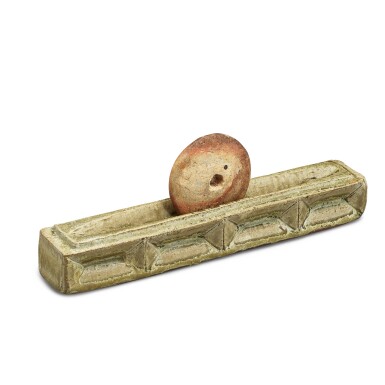Auctions
Buy Now
Collectibles & More
Books & Manuscripts
Echoes of Fragrance – Evolution of Tea Culture from the Tang to the Qing Dynasties
Echoes of Fragrance – Evolution of Tea Culture from the Tang to the Qing Dynasties

Lot Closed
December 16, 02:04 AM GMT
Estimate
20,000 - 30,000 HKD
Lot Details
Description
A rare green-glazed tea mortar,
Tang - Five dynasties
唐至五代 青釉茶碾
27 cm
In the Tang dynasty, fresh tea leaves were first steamed, then ground in a special mortar, later compressed into cakes and strung with reed or bamboo to dry. To brew the tea, the cake broken and ground into a fine powder, sifted, and boiled. A full set of gilt-silver teawares excavated from Famen Temple, Fufeng County, Shaanxi in 1987, provided solid material evidence to how imperial tea ceremonies were conducted during the Tang dynasty.
Whilst mortars made of gold and silver were reserved for royal use, ceramic mortars of similar nature were known to have produced in various kilns. Compare a closely related white-glazed rectangular mortar of similar form in the collection of China National Tea Museum in Zhejiang, Hangzhou is illustrated in their website http://www.teamuseum.cn/news/holding-detail.htm?id=526.
唐代時期盛行蒸青團茶,茶青採集後經過蒸青而成為餅狀。煮茶前需先將餅茶炙烤,再碾成細末,方可煎茶。茶湯亦會加放鹽或其他調味,故有「吃茶」一說。1987年,陝西扶風法門寺地宮出土一套唐代宮廷御用鎏金銀茶器,為唐代飲茶文化研究帶來重要證據。
茶碾用於碾壓餅茶成細末,是煎茶用的一種器具。茶碾由碾槽,碾軸兩部分組合而成。茶碾呈長方形,碾面上有一道溝槽以放碾輪。陸羽在《茶經》中稱碾輪為「墮」。碾輪呈碟形,中部有一圓孔,中間厚,邊緣薄而不施釉。陶製茶碾有見於各個窰口,多施白釉或青釉。杭州中國茶葉博物館藏有一近例,錄於其網站http://www.teamuseum.cn/news/holding-detail.htm?id=526。